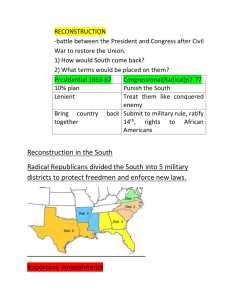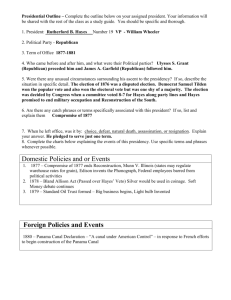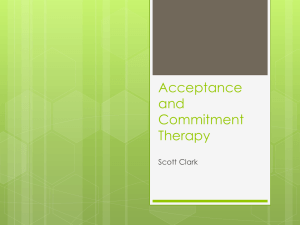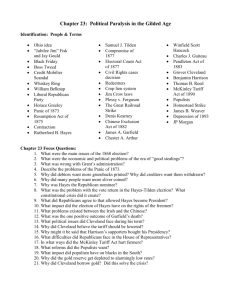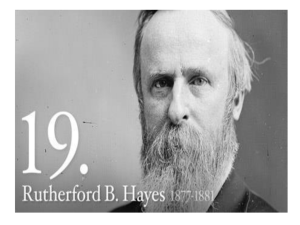ACT on stress - Association for Contextual Behavioral Science
advertisement
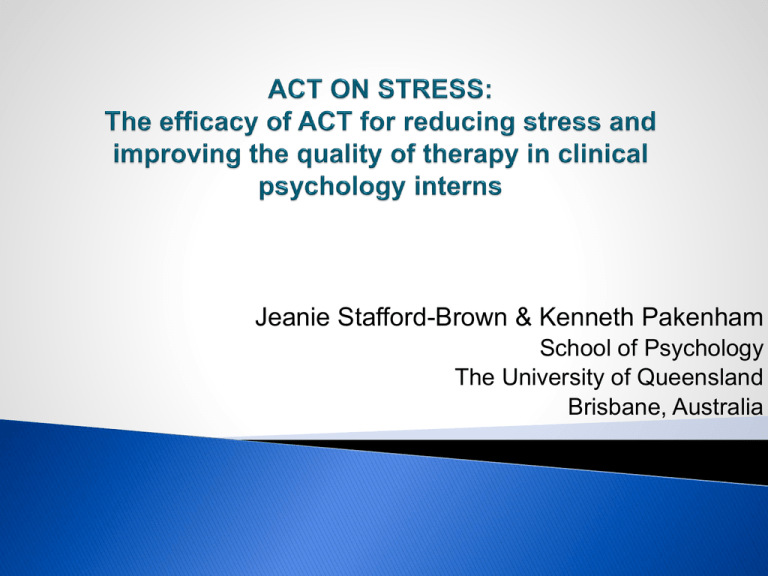
Jeanie Stafford-Brown & Kenneth Pakenham School of Psychology The University of Queensland Brisbane, Australia Elevated levels of stress in mental health professionals ◦ Clinical psychologists 29 - 74% (eg. Cushway et al, 1996; Gilroy et al, 2001; Guy et al, 1989) ◦ Trainee clinical psychologists 75% - (eg. Cushway, 1992) Excessive stress can negatively impact personal and professional functioning and result in less than optimal standards of care for clients Dearth of empirical studies on stress in trainee clinical psychologists, and there is no published intervention research Mindfulness-based interventions have been efficacious in similar populations e.g., med students, student counsellors To evaluate the efficacy of a group ACT stress management intervention for postgraduate clinical psychology interns in: ◦ reducing stress and enhancing adjustment ◦ fostering therapist characteristics associated with better therapy outcomes 1. Relative to a control group ACT intervention participants would report greater improvements in: ◦ Adjustment outcomes stress psychological distress life satisfaction ◦ Therapist qualities self-compassion self-efficacy therapeutic alliance ◦ ACT process variables 2. acceptance and action mindfulness defusion valued living That changes in adjustment outcomes and therapist qualities, would be mediated by changes in some or all of the ACT processes A non-randomised controlled trial with repeated measures Condition ACT Intervention Pre-treatment assessment Intervention Post-treatment assessment 10-week follow-up n = 28 n = 28 n = 27 n = 26 (2 universities) Control (2 universities) n = 28 n = 28 56 students from Australian Psychological Society accredited clinical post-graduate training programs at 4 universities in South East Queensland Inclusion criterion = current enrolment in the internship component of their degree No exclusion criteria Characteristics: ◦ ◦ ◦ ◦ Gender: 49 females; 7males Age: mean = 28.5 years (SD = 8.3; range = 21 to 52) Relationship status: 70% single Degree enrolled in: 57% masters degree 29% doctorate 14% PhD ◦ Full-time study = 95% ◦ 86% had completed their undergraduate studies in Queensland Adjustment Outcomes ◦ Stress Scale for Mental Health Professionals (MHPSS; Cushway & Tyler, 1996) ◦ General Health Questionnaire – 28 (Goldberg, 1981) ◦ Satisfaction With Life Scale (SWLS; Diener et al, 1985) Therapist Qualities ◦ Working Alliance Inventory-therapist version (WAI-SF; Horvath, 1991) ◦ Self-Compassion Scale (SCS; Neff, 2003) ◦ Counselor Activity Self-Efficacy Scales (CASES; Lent et al, 2003) ACT Processes ◦ ◦ ◦ ◦ Five Facet Mindfulness Questionnaire (FFMQ; Baer et al, 2006) Acceptance and Action Questionnaire (AAQ; Hayes et al, 2004) Valued Living Questionnaire (VLQ; Wilson & Groom, 2002) White Bear Suppression Inventory (WBSI; Wegner & Zanakos, 1994) Social Validation of the Intervention ◦ 14 forced choice – for example: whether personally and professionally useful whether participation increased their interest in ACT whether they had improved in the six core ACT processes whether they would recommend the intervention to other students whether it should be offered each year to new students ◦ 6 open-ended – for example: challenging aspects of the intervention would they continue to use ACT strategies/processes personally or professionally should ACT be included in clinical training Aims to: ◦ ◦ ◦ ◦ ◦ ◦ build rapport provide a brief overview of ACT undermine the effectiveness of experiential avoidance tactics illustrate that regarding thoughts and emotions, control is the problem, not the solution present willingness as the alternative to experiential avoidance introduce mindfulness as a willingness strategy Strategies: ◦ ◦ ◦ ◦ ◦ ◦ ◦ ◦ ◦ ◦ ◦ ◦ ◦ brief overview of ACT and RFT identify signs of stress and strategies used to deal with them explore effectiveness of these strategies in the short- and long-term The Man-in-the-Hole Metaphor (Hayes et al, 1999) Chinese Handcuffs Metaphor (Hayes et al, 1999) The Rule of Private Events (Hayes et al, 1999) Polygraph Metaphor (Hayes et al, 1999) The Chocolate Cake Exercise (Hayes et al, 1999) The Two Scales Metaphor (Hayes et al, 1999) Quicksand Metaphor (Hayes & Smith, 2005) mindfulness of breathing exercise (Harris, 2007) informal mindfulness exercises indentify “stress buttons” (triggers of stress) (Bond & Hayes, 2002) Between Session Practice: ◦ Notice how cognitive avoidance and cognitive struggle amplifies or helps maintain the stress process, when your “stress buttons” have been pressed (Bond & Hayes, 2002) ◦ Practice mindfulness of breathing from CD once every day ◦ Do one “informal” mindfulness activity daily Aims to: ◦ Broaden repertoire of mindfulness exercises ◦ build willingness/acceptance by defusing language ◦ foster contact with the “observing self” & undermine attachment to conceptualised self Strategies: ◦ Guided mindfulness ◦ Body Scan (Walser & Westrup, 2007) ◦ Participants instruct facilitator how to walk from chair to door - response to each instruction “how do I do that” (Luoma et al, 2007) ◦ Milk, Milk, Milk Exercise (Hayes et al, 1999) ◦ twinkle, twinkle, little ……. (Hayes & Smith, 2005) ◦ What are the Numbers Exercise (Hayes et al, 1999) ◦ Passengers on the Bus Metaphor (Hayes et al, 1999) ◦ defusion techniques discussed and practiced ◦ Leaves on a Stream Exercise (Hayes & Smith, 2005) ◦ Bad Cup Metaphor (Hayes et al, 1999) ◦ substituting self-referential uses of the word “but” with “and” (Hayes et al, 1999) ◦ Chessboard Metaphor (Hayes et al, 1999) ◦ Observer Exercise (Hayes et al, 1999) Between Session Practice: ◦ Practice “Leaves on a Stream” track 4 on CD (12 mins) and “The Observing Self” track 5 on CD (15 mins) by alternating each day ◦ Experiment daily with other defusion techniques outlined in handout Aims to: ◦ ◦ ◦ ◦ Strategies: ◦ ◦ ◦ ◦ ◦ ◦ promote willingness of difficult internal events clarify values as chosen life directions identify and undermine barriers to values-based action link willingness & values-based action Passengers on the Bus Metaphor Tin Can Monster Exercise (Hayes & Smith, 2005) Eulogy Exercise (Bond, 2004) Values Worksheet Values Assessment Rating Form The Bubble in the Road Metaphor (Hayes et al, 1999) Homework: ◦ Practice the Tin Can Monster Exercise from CD daily using the stress buttons identified in session 1 ◦ Continue daily practice of defusion techniques and “informal” mindfulness ◦ Reflect on values Aims to: Strategies: ◦ identify values as a therapist ◦ identify value-directed goals, and related barriers ◦ highlight the experiential qualities of applied willingness, and the nature of commitment ◦ understand the link between willingness and commitment ◦ introduce the notion of self-compassion, and highlight its relevance to selfcare and the ACT therapeutic stance ◦ bring it all together ◦ ◦ ◦ ◦ ◦ ◦ ◦ ◦ ◦ Guided mindfulness exercise Identifying Your Values as a Therapist Exercise (Luoma et al., 2007) The Bubble in the Road Metaphor revisited (Hayes et al, 1999) Goals Actions & Barriers Form completed (Hayes et al, 1999) The Joe the Bum Metaphor (Hayes et al, 1999) The Jump Exercise (Hayes et al, 1999) Swamp Metaphor (Hayes et al, 1999) Self-compassion introduced - Loving Kindness Meditation (Harris, 2007) FEAR and ACT algorithms (Hayes et al, 1999) Clinical background % n Counselling/therapy exp 50 28 Meditation training 25 14 Current meditation practice None Very occasional Once per week 63 31 6 34 17 3 Training in MBSR 21 12 Training in MBCT 6 3 Training in DBT 4 2 Training in ACT 9 5 Satisfaction with clinical training (5-point response scale - 1 “totally dissatisfied” to 5 “totally satisfied”) ◦ Mean = 3.60 (SD = .80; range 1 - 5) At Pre-treatment ‘Caseness’ Levels using GHQ (cut-off score of ≥ 5) = 73% Adjustment outcomes Relative to the control group the intervention group reported lower: Stress Psychological distress (Somatic symptoms) Therapist characteristics & therapeutic alliance Relative to the control group the intervention group reported greater improvements in: Self-compassion (overidentification) Self-efficacy (insight skills) Therapeutic alliance (bond) ACT processes Relative to the control group the intervention group reported greater improvements in: Acceptance and action ◦ Willingness) Mindfulness ◦ Acting with awareness ◦ Non-judging Defusion Valued living All treatment gains were maintained at the 10-week follow-up Bootstrapped nonparametric multiple mediator tests showed that ACT processes mediated changes in: ◦ ◦ ◦ ◦ ◦ psychological distress somatic symptoms self-compassion (overidentification subscale) self-efficacy (insight skills) therapeutic alliance (bond subscale) Key ACT mediators: ◦ ◦ ◦ ◦ ◦ present moment awareness self-as-context defusion acceptance values action o minimal attrition o take up of options to join other group or 1:1 session o on time and stayed until the end of each session o high participation in discussions o high participation in experiential exercises o 82 – 97% did some between session practice each week ◦ personally useful M = 3.9 (1 “not useful” – 5 “very useful”) ◦ professionally useful M = 3.9 (1 “not useful” – 5 “very useful”) ◦ 96% increased interest in ACT ◦ 96% ACT offered as part of training ◦ 78% would recommend the program (22% unsure) ◦ all reported improvement on 1 or more ACT processes ◦ 92% personally use ACT strategies or processes ◦ 85% professionally use ACT strategies or processes Resilience for every Day Nicola Burton, Ken Pakenham, Wendy Burton 23 Resilience = effective coping and adaptation in the face of significant life challenges (Tedeschi & Kilmer, 2005) It is characterized by good mental and physical health, functional capacity, and social competence, despite cumulative and current stressful life events. Resilience is a dynamic process of adaptation to stressful events that involves an interaction between protective factors & stressors. Prior research focused on: ◦ children ◦ specific resilience-related intra-personal characteristics ◦ individuals in specific adverse circumstances (eg. chronic physical illness, bereavement, divorce) 5 key resilience protective factors (Southwick, Vythilingam & Charney, 2005) 1. 2. 3. 4. 5. Positive emotions Cognitive flexibility Meaning Social support Active coping strategies (eg. problem solving, positive reappraisal, humour, acceptance, exercise) Each protective factor shown to be related to: ◦ ◦ ◦ ◦ better mental health lower risk of disease better health outcomes for those already diagnosed with illness neurobiological resilience factors (eg. a highly functional dopaminemediated reward system) (Ryff & Singer, 2003; Southwick et al., 2005) Resilience training targets protective factors that can be modified, to increase an individual’s hardiness for remaining healthy in the face of cumulative stress. Few intervention studies have attempted to increase resilience among adults in the general population. ◦ Worksite RCT (prevention): Improvements in resilience, self esteem, locus of control, life purpose, & interpersonal relations (Waite & Richardson, 2004) ◦ Diabetes: negligible improvements relative to care-as-usual group (Bradshaw et al., 2007) ◦ Worksite trial (ill participants): increases in effective coping and decreases in depression (Steensma et al, 2006) CBT and ACT informed intervention involved 11 x 2 hour group-based sessions over 14 weeks Session format: ◦ ◦ ◦ ◦ ◦ ◦ discussion experiential exercises skills rehearsal and practice didactic input between session practice activities review of between session practice Resources: ◦ participant manual ◦ CD ◦ therapist manual Session Session topic Assessment 1 Introduction 2 Physical Activity 3 Mindfulness 4 Defusion I 5 Defusion II 6 Acceptance 7 Review and Consolidation 8 Values and Meaningful Action 9 Social Support 10 Relaxation and Pleasant activities 11 Review and Planning for the Future Evaluation Welcome, general introductions & housekeeping What is resilience? READY model of resilience Warning signs of low resilience READY program overview Introduction to READY workbook and READY personal plan Review and READY personal plan Feeling Positive emotions Doing Coping strategies Resilience Cognitive flexibility Social support Thinking Meaning Being Relations Physical activity & resilience Physical activity recommendations Physical activity definitions and domains Step counting, pedometers and sitting time Physical activity and goal setting Physical activity and problem solving Session 3: Mindfulness ◦ Mindfulness of: eating sultana, environment, breath, body ◦ CD Session 4: Defusion I Session 5: Defusion II (including observer self) Session 6: Acceptance Session 7 : Review Session 8: Values Session 9: Social Support & Connectedness Session 10: Relaxation & Pleasurable Activities Session 11: Planning for the Future Pre-post single group design 18 volunteers recruited from administrative staff at University of Queensland 15 women; 3 men mean age 36.5 years (SD 8.6) were 2 drop-outs Psychological Well-being (Ryff, 1989) autonomy environmental mastery personal growth positive relations purpose in life self-acceptance Depression (CES-D; Radloff, 1977) ◦ ◦ ◦ ◦ ◦ ◦ Stress & Anxiety (DASS-21; Lovibond & Lovibond, 1995) Positive affect (PANAS-X; Watson & Clark, 1999) Values (Valued Living Questionnaire, Wilson & Groom, 2002) Mindfulness (Mindful Attention Awareness Scale, Brown, 2003) Acceptance & Action Questionnaire II (AAQII; Hayes et al., 2006) MOS Social Support Survey (Sherbourne & Stewart, 1991) Physical activity ◦ Self-reported time spent in physical activity in previous week total time spent in walking for transport, for exercise or recreation, moderate & vigorous physical activity (summed to provide a measure of activity minutes/week) ◦ Daily steps for 7 consecutive days recorded by pedometer (used to derive average steps/day) BMI Blood pressure (BP_Sys and BP_Dias) Hematological data involved a fasting blood sample to measure: ◦ ◦ ◦ ◦ blood glucose total cholesterol C-Reactive protein (CRP) cortisol Data were analyzed using standardized mean differences and paired t-tests. There was a significant difference between baseline and post intervention scores on measures of: ◦ ◦ ◦ ◦ ◦ ◦ ◦ ◦ ◦ ◦ mastery (p=.001) positive emotions (p=.002) personal growth (p=.004) mindfulness (p=.004) acceptance (p=.012) stress (p=.013) self acceptance (p=.016) valued living (p=.022) autonomy (p=.032) total cholesterol (p=.025) The average proportion of sessions attended = 81% 3 participants attending all 11 sessions 37% (n=6) missed 1 or 2 sessions 44% (n=7) missed 3 or 4 sessions The most common reasons given for missing sessions were clashes with work meetings and planned recreation leave. High level of in-session participation Satisfaction: the mean rating 4.67 ◦ (5-point scale; 5 excellent & 4 very good) Personal helpfulness: mean rating 4.44 ◦ (5-point scale; 5 a lot & 4 moderately so) Workbook: mean rating 3.87 ◦ (4-point scale; 4 very helpful & 3 moderately helpful), READY Personal Plan: mean rating 3.5 75% agreed with weekly frequency 87% agreed with 2 hour session duration 56% agreed with overall program length (31% thought it was too short) Cluster randomized trial 75 participants allocated to either a waitlist or 1 of 2 intervention conditions: ◦ READY including physical activity module ◦ READY excluding physical activity module Both intervention conditions received a 10x2.5 hour group resilience training program (READY) over 13 weeks. Measures as per pilot Clinical Training: ◦ Group READY program in University Psychology Clinic ◦ Experienced facilitator + 3 trainee clinical psychologists as co-facilitators ◦ Target population: people referred to clinic ◦ Screening ◦ Group sessions + 5 individual sessions with trainee psychologists Coping with Chronic Illness Carers
